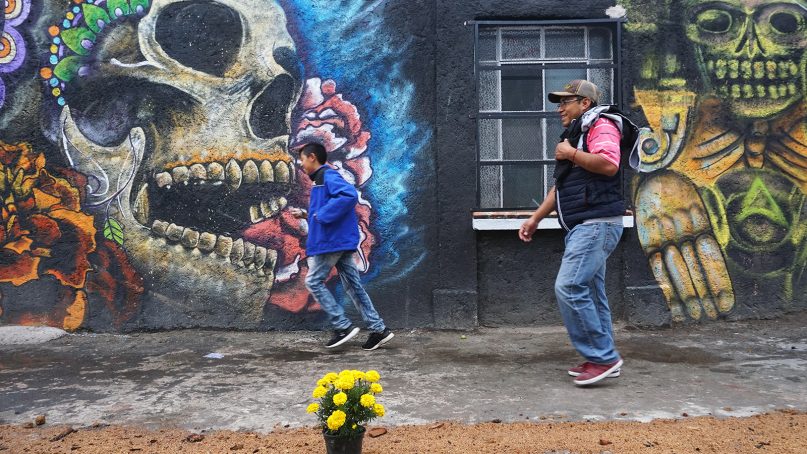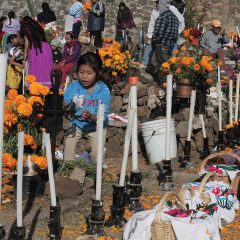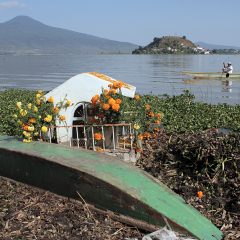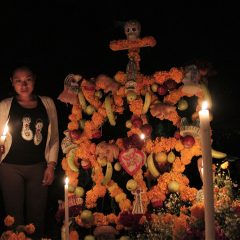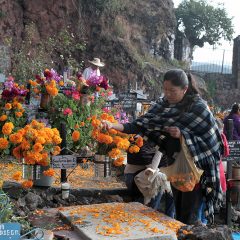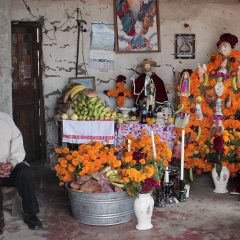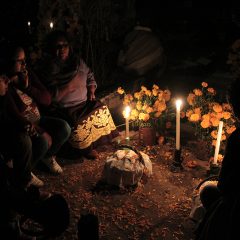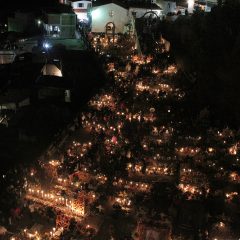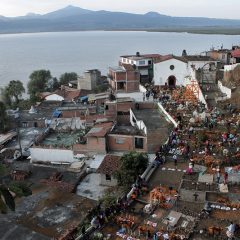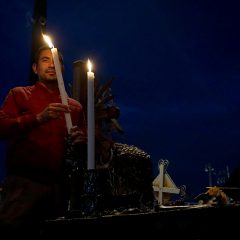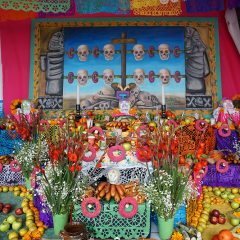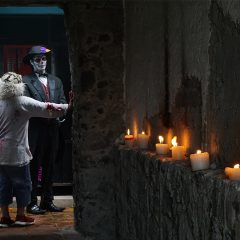SAN ANDRÉS MIXQUIC, Mexico (RNS) — In popular markets in Mexico in the early fall, a passerby’s eyes are filled with the colorful ornaments and offerings dedicated to the deceased. With the approach of the Day of the Dead, known as Día de los Muertos in Spanish, death becomes a way of life in Mexico.
“It may just be possible to live after having died,” wrote the late Mexican poet Xavier Villaurrutia, and in Mexican families, the remembrance of loved ones is so frequent and natural that it can seem as if the deceased has never died.
- Families gather at the Janitzio Island cemetery for Day of the Dead celebrations in western Mexico. RNS photo by Irving Cabrera Torres
- A man paddles near the island of Janitzio on Lake Patzcuaro in western Mexico. A memorial to a man who drowned in the lake is decorated for Day of the Dead in the foreground. Day of the Dead is the chief celebration of the year on Janitzio. RNS photo by Irving Cabrera Torres
- A woman at an altar in the Janitzio Island pantheon, or cemetery, during Day of the Dead. The decorative, flowered part of the altar symbolizes the entrance door to the world of the dead, the path that must be followed to reach Mictlán, the place of the dead in the pre-Hispanic culture. RNS photo by Irving Cabrera Torres
- Cempasúchil flowers, in the marigold family, are traditionally used for Day of the Dead decorations. Petals are used to mark a path that the souls of the deceased should follow toward the altars erected in their honor. It was traditionally believed that petals kept the heat of the sun and illuminated the way back to the deceased. RNS photo by Irving Cabrera Torres
- A man sits with a traditional Day of the Dead offering at his home in Janitzio. RNS photo by Irving Cabrera Torres
- A family brings a basket of food to the grave of a dead relative to share the food with the soul of the deceased while celebrating Day of the Dead on Janitzio Island. RNS photo by Irving Cabrera Torres
For centuries, Mexicans’ devotion to death has been present in festivals, rituals, literature, music and other arts. Mesoamerican cultures celebrated death before Europeans ever came to influence the Americas. Many pre-Hispanic peoples of Mexico kept skulls as trophies and displayed them during rituals that symbolized death and rebirth. Pre-Hispanic gods such as Mictecacíuhatl, the “Lady of Death,” and Mictlantecuhtli, “Lord of the Land of the Dead,” are still prevalent in current Day of the Dead celebrations.
- Candles illuminate the Janitzio Island pantheon, or cemetery, during the Day of the Dead. RNS photo by Irving Cabrera Torres
- Dawn breaks over Janitzio Island after the Day of the Dead. RNS photo by Irving Cabrera Torres
Janitzio, an island in Lake Pátzcuaro in the western Mexico state of Michoacán, has large, traditional Day of the Dead celebrations. Offerings of flowers, bread, fruit, food and candles adorn the pantheon, or cemetery, on the island. Locals sit through the night, contemplating the flames of their candles and murmuring prayers for the souls of the dead to descend from heaven.
The town of San Andrés Mixquic, southeast of Mexico City, has a somewhat more modern celebration of the holiday, with painted faces, store-bought decorations and technology mixing with traditional elements.
- Candles are kept lit all night in cemeteries to allow spirits of the deceased to pass during Day of the Dead in San Andrés Mixquic. RNS photo by Irving Cabrera Torres
- Traditional Day of the Dead offerings in San Andrés Mixquic, southeast of Mexico City, include bread, fruit and cempasúchil flowers. Also common are images of the tzompantli, or skull rack, harkening back to displays of human sacrifices in Mesoamerican civilizations. RNS photo by Irving Cabrera Torres
- Candles are placed for forgotten souls in San Andrés Mixquic, southeast of Mexico City, on Nov. 1, 2018. RNS photo by Irving Cabrera Torres
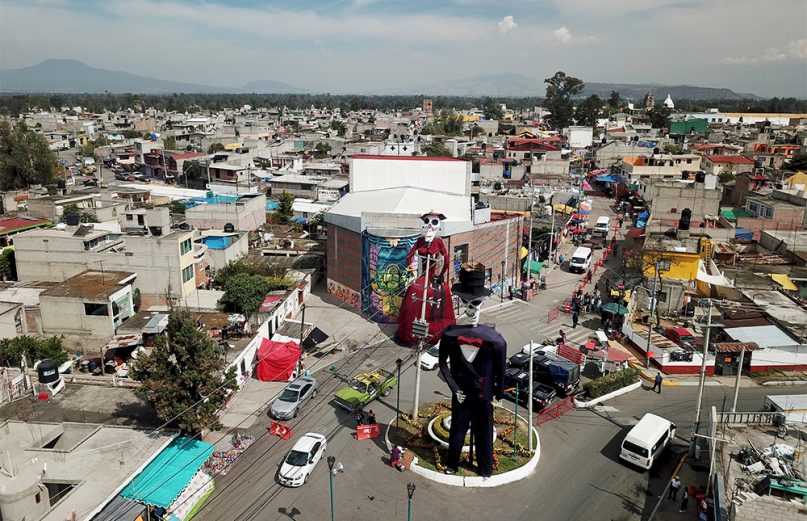
San Andrés Mixquic, a town southeast of Mexico City, has a long tradition of celebrating the dead. RNS photo by Irving Cabrera Torres
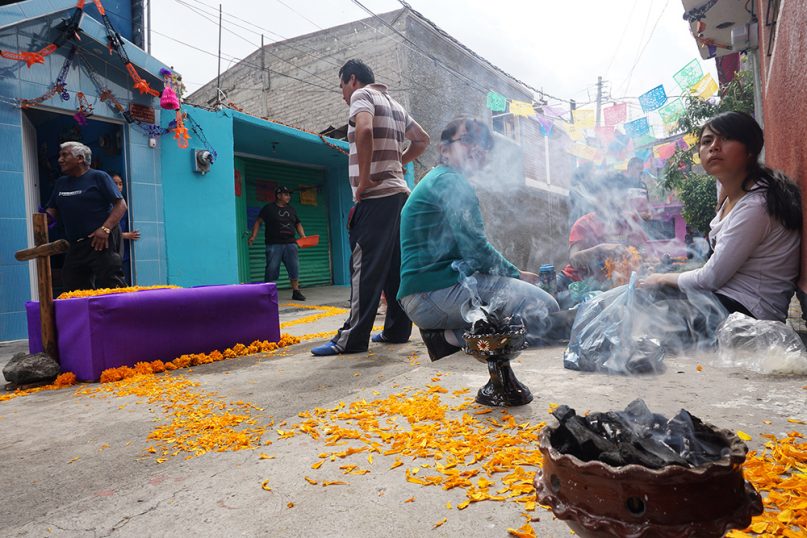
Incense burns in San Andrés Mixquic beside a fake coffin on the street, adorned with cempasúchil petals, as a Day of the Dead offering to deceased ancestors. RNS photo by Irving Cabrera Torres
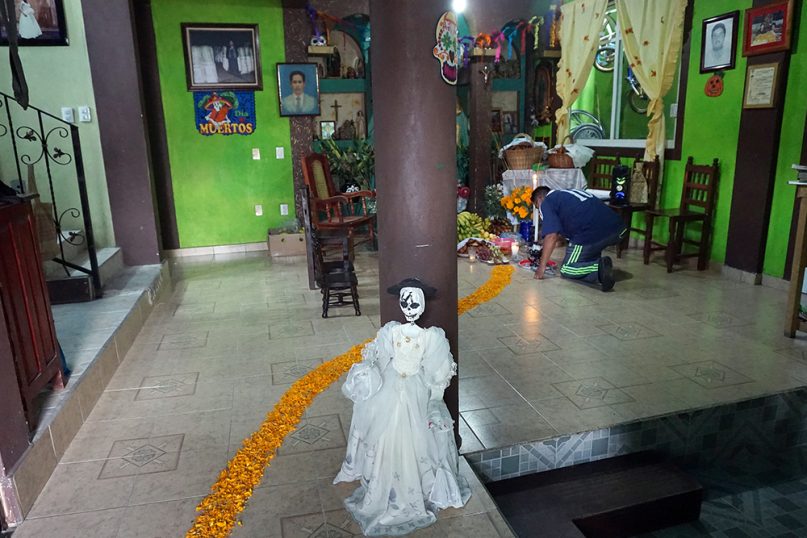
A path of cempasúchil petals leads to the altar of the dead in a San Andrés Mixquic home on Nov. 1, 2018. The petal path is thought to lead deceased spirits to the home and the offering. RNS photo by Irving Cabrera Torres
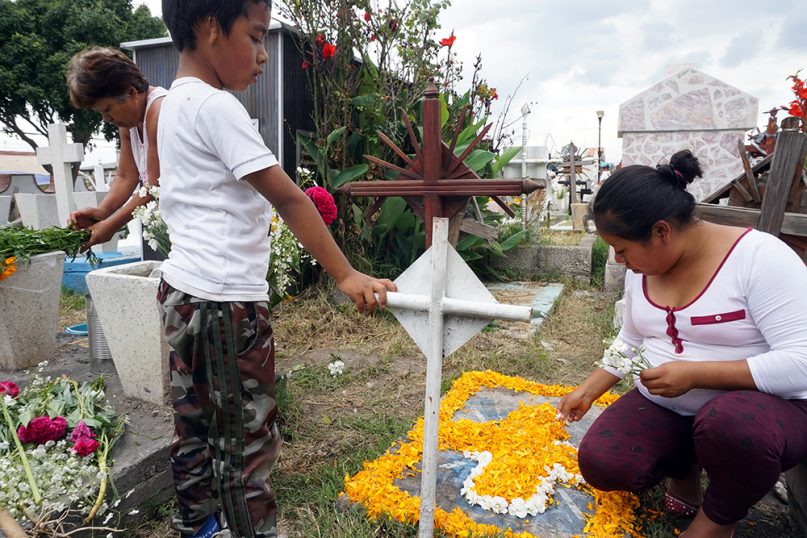
“Uncle Betito’s grave is always adorned with yellow and white flowers because he died when he was a child,” said the Rodríguez family while making Day of the Dead preparations in San Andrés Mixquic on Nov. 1, 2018. RNS photo by Irving Cabrera Torres
